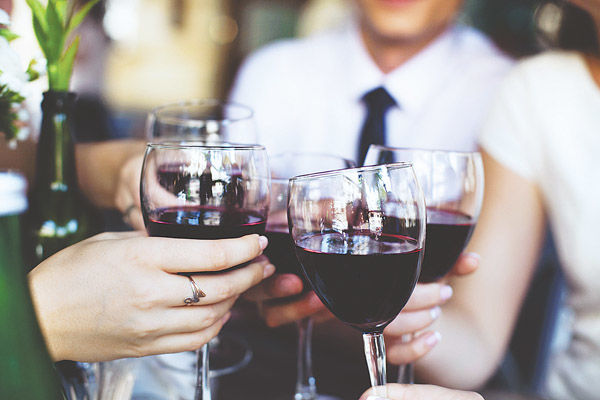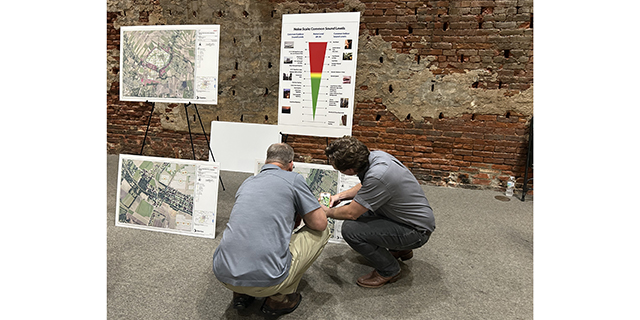Food and Wine
Published 5:00 am Wednesday, April 18, 2018

- Wine is more than an alcoholic beverage, it can be a flavor enhancer with the right food pairings.
Unexpected pairings for spring feasts
Some could say pairing a story about food and wine pairings with National Animal Cracker Day is an odd combination. Then again, I’ve known a few animals that get crackers when they induldge in too much wine. Simply put, wine does not have to be Darth Vader in the food world. Rather, learning how to compliment a meal with the right wine can make for a fine dining experience whether you are at home or in a restaurant.
Spring is here, which means it is time to create sensational seasonal wine and food pairings to elegantly entertain family and friends. Experts suggest Cabernet Sauvignon as a selection well suited for the transition to warmer temperatures, as the bold, bright red and black fruit flavors with hints of spice pair easily with both hearty and lighter fare.
“Cabernet Sauvignon is more versatile than most believe. It can be enjoyed with different cheeses, meats, vegetables and even certain types of fish,” says Molly Hill, Winemaker at Sequoia Grove Winery.
For a classic expression, consider Sequoia Grove Winery’s Napa Valley Cabernet Sauvignon. This tempting red wine maximizes the distinct flavor characteristics of its origin, the Rutherford Bench, one of Napa Valley’s most revered growing regions for Cabernet.
At your next spring dinner, try serving the Sequoia Grove 2015 Napa Valley Cabernet Sauvignon, a full-bodied wine featuring notes of sweet vanilla and spice, followed by blackberry, strawberry and berry pie aromas.
For a timeless pairing, try today’s recipe for Roasted Leg of Lamb. This dish balances well-seasoned lamb with the acid in citrus to create a delicious pairing with an elegant Cabernet Sauvignon.
Lasting Tradition
In the 1980s Kathlyn Hurst was fully into blending wine with food. It was her parents, Hulo and Eugenia Landry, that started Poor Boy’s Riverside Inn in Lafayette in 1932. In 1958 Kathlyn and her husband Larry took over management. In 1988 their children Richard and Elaine opened Little River Inn in New Iberia.
Lori Hurst said when she and Richard were dating, Mrs. Hurst was always pairing food with wine, different dishes, different wines trying to find the perfect match.
“She got excited about wine in the early 80s and took a trip to the California Wine Country, tours and tasting,” Richard Hurst said. “Tastes have changed, become more sophisticated since then, but still if you have a nice glass of wine, it makes the meal relaxing and enjoyable.”
The Little River Inn menu of wines states, “Wine lovers agree that wine is a natural accompaniment to a fine meal. A meal without wine is a meal without salt and pepper. Drink a glass of wine encourages leisurely dining and lowers your stress level.”
More than 30 wines are featured at the restaurant, some by glass others only by the bottle.
Pairings are stated in the menu for some of the wines with favorite dishes. For example, Apothic White, a blend of Chardonnay, Riesling and Moscato, offers intense flavors of peach, pineapple, a hint of oak and vanilla. It pairs well with Little River Inn’s Grilled Stuffed Flounder.
Can you imagine having a palette that is so sophisticated that you can taste the flavors mentioned above?
Or how about Franciscan Magnificat, a ripe, rich fruit of blackberries, plums, black cherries with notes of chocolate and cinnamon. Great with Filet Mignon Riverside. Sounds like a pair I’d like to try. It’s only sold by the bottle, so bring friends.
New Friends at an Old Spot
Just down Main Street, still reveling in the reopening is Clementine on Main. Mike Parich said he learned most of his wine and food pairing by dealing with people from all over the world, listening to their comments.
The typical white wine with white food like baked fish, crabs and other seafood is the standard. Bold red meat with red wines, bold with bold flavor.
However, Parich is quick to say it is not the same with fried fish and seafood. Nothing goes better with fried foods than a beer, he said. The only local brew he serves is Canebrake. During the spring, they also have a Strawberry Canebrake which Parich said pairs very well with boiled seafood as well.
“With so many spices and tastes with seafood, it helps to smooth out with the strawberry flavor,” Parich said. “Canebrake is the only local brew we serve at Clementine.”
When it comes to red wines, Parich said the dry bold red is best. The staff is eager to make recommendations based on the types of wine customers prefer, supporting his philosphy of Eat, Drink and Visit. The conversation over which wine to order is part of the dining experience.
To end the meal, the house champagne is is a rosé but they have others up to the Dom Pérignon Rosé, when money is no object.
And he should know. Born on January 1, Parich said he has tasted a lot of champagne through the years. The holiday birthday is also the reason for his love of music, parties, food, friends, all his passions, that make life a celebration every day of the year.
Pairing Wines with Food
According to Wine Enthusiast Magazine, wine flavors are derived from specific components: sugar, acid, fruit, tannin and alcohol. Foods also have flavor components, such as fat, acid, salt, sugar and bitter. The most successful food and wine pairings feature complementary components, richness and textures.
Try for either a similar pairing or a contrasting one. For pasta in a rich cream sauce, for example, you could cut through the creamy fat with a crisp, dry, unoaked white wine. Or wrap the flavor of the wine around the richness of the sauce by choosing a big, ripe, soft Chardonnay or Roussanne/Marsanne blend.
Here are a few elements that make both red wine and white wine pairings work, as recommended by WineMag.com.
Fat Element — A lot of favorite foods, both meat and dairy products, have high levels of fat. Wine doesn’t contain fat, so when matching a wine with fatty foods, remember to balance that fat with acid, cut it with tannin, or match its richness with alcohol. This is why a prime cut of steak tastes so good with a Cabernet-based wine; the beef’s protein and fat softens up the wine’s mouth-drying tannins. This sets up the tongue for the wine’s fruit and berries and forest flavors to complement the smoky, meaty flavors of the steak.
Acid Element — Acid is another key element in both food and wine. In wine, it adds nerve, freshness and lift. It can do the same with food, as when lemon is squeezed on a fresh piece of fish. When looking for a wine to go with an acidic dish, make sure the perceived acidity of the wine is at least equal to that of the food, or the wine will taste bland and washed out. Salads are often a challenge for wine matching, but to make it work, moderate the acid in the dressing by cutting back on the lemon juice or vinegar. Try using some tangy, bitter greens and offset them with herbal flavors from Sauvignon Blanc or Sémillon.
Salt Element — Salty foods seem to limit wine choices. Salt can make an oaky Chardonnay taste weird, strip the fruit right out of a red wine and turn high alcohol wines bitter. But with a bit of imagination, some remarkable combinations of salty foods and sweet wines can be found. Bleu cheese and Sauternes is another one of the world’s classic food and wine combos.
Sweetness Element — Sweet desserts and other sugary foods seem easy — just pull out a sweet wine — but beware. There are degrees of sweetness. Some recipes will have just a hint of sugar, such as a fruit sauce served over a pork loin. This light, fruity sweetness can be matched very well with rich white wines such as Chardonnay. Higher alcohol tends to give an impression of sweetness and balances the sugar in the sauce. With desserts be certain the wine tastes sweeter than the dessert; otherwise the dessert will strip the wine of its sweetness and render it bitter or tart. Though red wine and chocolate is a combination often promoted by the wine industry, be very careful. Use a bitter, dark chocolate and a red wine with some sweetness, such as a late harvest Zinfandel, and it can be quite wonderful. But a sweet chocolate dessert and a dry red? Terrible!
Bitterness Element — In some cultures, bitter flavors are prized, but most of the time they are to be avoided. Anything more than just a hint is likely to be perceived as unpleasant. In wine, bitterness usually results from unripe grapes, or a failure to get the stems and pips (seeds) out of the fermenting tank, or mismanaged barrels. When bitterness in wine meets bitterness in food, it acts the opposite of sugar. One does not cancel out the other; they merely combine.
Texture Element — As for matching textures, think light and heavy. Light foods are best with light wines; heavy foods with heavy wines. That’s the safest way to go about it. A more adventurous path is to experiment with contrast: matching light foods to heavy wines and vice versa. This will require more testing, to keep the tension dynamic and avoid having the lighter flavors over-shadowed by the heavy ones.
For every rule of wine pairing there is often just as many dissenters. However, the most important rule of all is to trust your own palate, Wine Enthusiast.com said.
EDITOR’S NOTE: A portion of this article was provided by StatePoint Media.





